Originally posted 08.05/2016
Practice Snippets; Why the Bladder may be the Victim, not the Culprit, when your cat urinates outside the litter tray box.
It is a given that there are many medical, dietary, behavioural and environmental issues why your cat may have bladder disease or spray indoors etc. Any cat with these issues should be under the direct care of their vet.
However, there is also a background level of ignorance and lack of knowledge that we as owners (even vet owners) insist on inflicting on our poor cats, that then plays a huge role in increasing the risk of triggering illness in our cats. One of our major ways we fail our cats as their owners is what we have provided to them for so long as their litter tray or toilet box.
- Litter Trays
Most of the small open cat litter trays sold everywhere are simply too small a size for all bar a kitten. A litter tray should be at least 1.5x the length of your cat… yet most of what I see in supermarkets etc. are simply too tiny for an adult cat. As a result, this small size makes the cat sit in an odd tucked up squatting position which means the bladder may not fully empty each time. This can set up the cat up for bladder problems further down the line.
The covered tray litter boxes tend to be larger in length but not wide enough and being so narrow, there is not enough room for cats to turn around without bending. As cats age, often they walk halfway inside the box, stop there, don’t turn around and then spray out the arch out onto the floor. (In the case of a Siamese, often up to a metre away!) The owner finds the mess, presumes there is a loss of toilet training skills in old age and puts it down to dementia or arthritis. Yet, the cat doesn’t need medication; all it needs is an age- appropriate litter box.
Extra-large commercial litter boxes may resolve some of the issues but at $200 are often too expensive for many of my clients.
Many cats, but especially the males, like to arch up as they urinate and so they hit their heads on the roof of the very covered litter trays we were advised to use so as to give the nervous cat more security whilst it was urinating. Instead, we can make such a cat paranoid about using the covered trays.
Behaviourist specialists suggest that the flap on a litter tray entrance may also be one step too many for a cat with bladder issues. Tall cats (esp. Siamese) generally hate flaps which sit on their heads or flip down and trap them in their own urination fumes, so they will avoid using those fully enclosed litter boxes at all cost.
Classic traditional style commercial boxes (A & B) with all the inherent issues of:
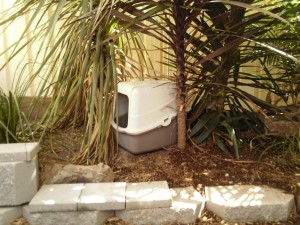
Image B
- Not high enough for cat to arch up
- Not wide enough for cat to turn around
- Not long enough so the cat can’t get deep into the box and hence away from the open entrance.
End result – arthritic cats can’t turn around so they put half their body inside, rear end facing out, do a half squat and out sprays the urine on the floor.
What is very affordable is a long shallow under-bed plastic tray found in any Reject Shop/Clearance store or Kmart etc. for less than $20 which can be filled with litter. Commercial litter trays for those dimensions would normally cost closer to $100 in some pet outlets which many owners can’t afford especially when cats need more than one litter tray. The Kmart option workaround is affordable for most owners and means cats will then get the extra litter trays they need.
You can leave the box uncovered (C) or use a disposable cardboard covers (D) or slide it inside a deeper box that is sitting upright on its end.
I sometimes leave a litter tray outdoors as some cats prefer to always use a tray inside or out. It also makes it much easier to keep a garden cleaned up of cat faeces.
I have long believed we need someone to design a litter tray for male cats with a tray of high front and back walls and a high roof. For tall Siamese or cats who don’t squat down well or for long enough, the urine overshoots the catcher tray. I decided to make my own deep walled indoor litter tray (E) the cat could turn around in, to arch up in and also tall enough to keep the urine in the tray. I didn’t achieve a roofed version but this one blue box works well (costs about $15 in warehouses). End of problem as the spray hits the tall wall and slides back into the litter. As the cat ages, a small outside step into the box can also help an arthritic cat use the deeper boxes-a simple cheap washable plastic footstool can be used as the step. Some owners put a small plastic box one to end of the box inside that really old cats can use to step back out.
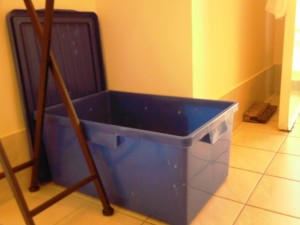
Image E
Several clients have found cutting an entry door at different points along a selection of these cheap plastic storage boxes will allow cats in multiple households to select which style of box suits them. The cost of these deep-sided litter-trays requires very little financial outlay by the owner. This ensures the rule of one litter-tray more than the number of cats is affordable and hence improves compliance.
Again (G) or (H) can be left open-topped or just use the lid that comes with the box to make a roof if your cat prefers a covered top.
- Reasons your cat might use your bed as its litter tray.
If your cat insists on using your bed as a litter tray then this cat may need additional modifications to help them urinate in the correct place. A highly stressed cat or one in a multi-pet household sees your bed as having advantages other sites in the house do not offer.
For starters, the bed is elevated and usually backed up against a well. This provides a high vantage point for the cat to view any unwanted intruders or detect potential ambushes from other pets that might normally lie in wait outside a covered box ready to pounce when the anxious victim exits the box. The cat can’t be ambushed from behind as the solid wall of the bed head provides a safe barrier so they can back up to it and still have a panoramic guarding view of the room. The bed also has a great litter substrate, soft and absorbent and best of all having a strong scent of the protective human owner.
It is simply not enough to make sure this cat is locked out of your bedroom. The anxiety which triggered the behaviour still needs to be addressed and you have to provide an alternative elevated area for their litter tray as well. Often placing a wide flat open litter tray up on the corner of the laundry bench (so ambush risk neutralised on 2 sides) or on top of a solid bench or shelf in the garage provides a great alternative option for your cat. These cats may also be finding your first choice of litter too hard and hence the preference for the bed linen.
Consider using something like Breeder’s Choice rather than pearl beads etc for the soil substrate in these litter boxes.
Always have lids on your laundry baskets and litter storage bins as well otherwise the cat may choose to use these as litter trays.
So, remember the rules to help you protect your cat’s bladder from some of the triggers for bladder accidents indoors.
- Match the size of the litter tray or box to the size, age and health of your cat.
- Provide one more litter tray or box than the number of your cats – two for one cat, three for two cats etc.
- Consider placing boxes at different heights and in different spaces
- Provide 2 different types of litter substrate of different textures and observe which one your pet prefers.
- Always first seek medical advice promptly if you think your cat is having a bladder issue as the ideas offered above are preventative and supportive options: the tips above don’t address infection and disease etc. so never delay taking a cat with odd urination patterns or behaviour to your own vet first.
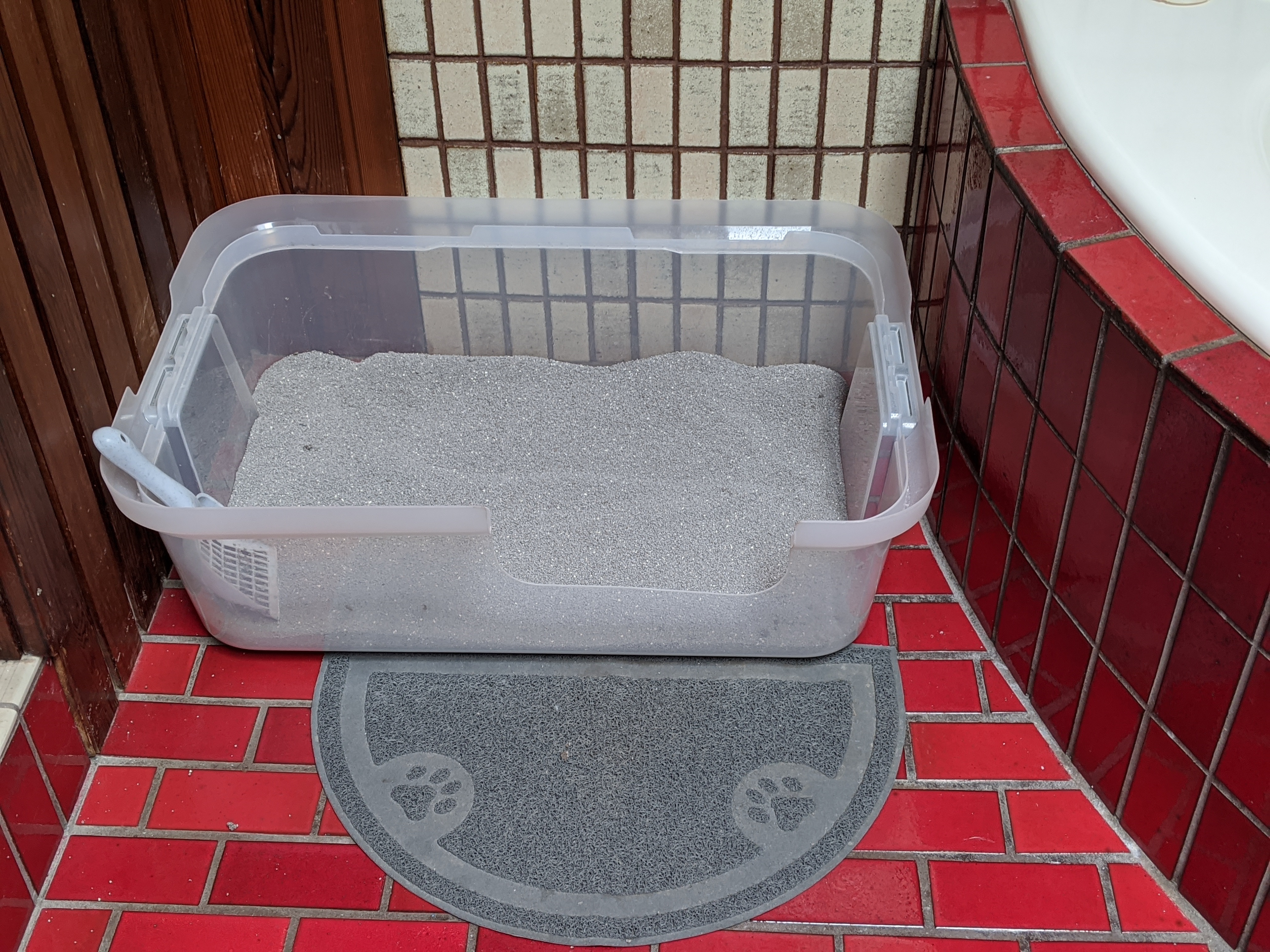
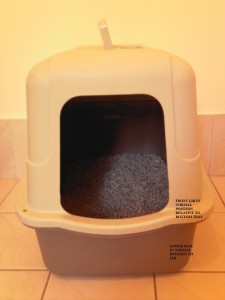
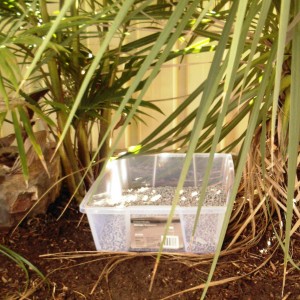
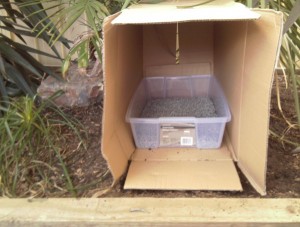
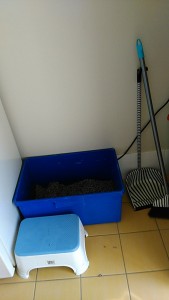
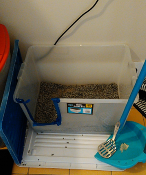
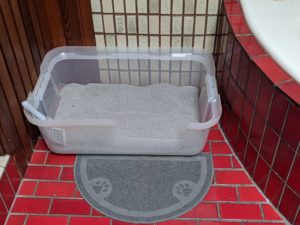
What great advice! My male cat sometimes sprays the wall now when in the litter tray and I didn’t know why. But I did know the tray was too small but struggle to find one that it narrow enough to fit where it goes in the laundry, so he had privacy, and long enough for him. But now the high wall makes so much sense, so it doesn’t matter if he does it or not. I didn’t even think of just using a tub from a warehouse. I will look into it x